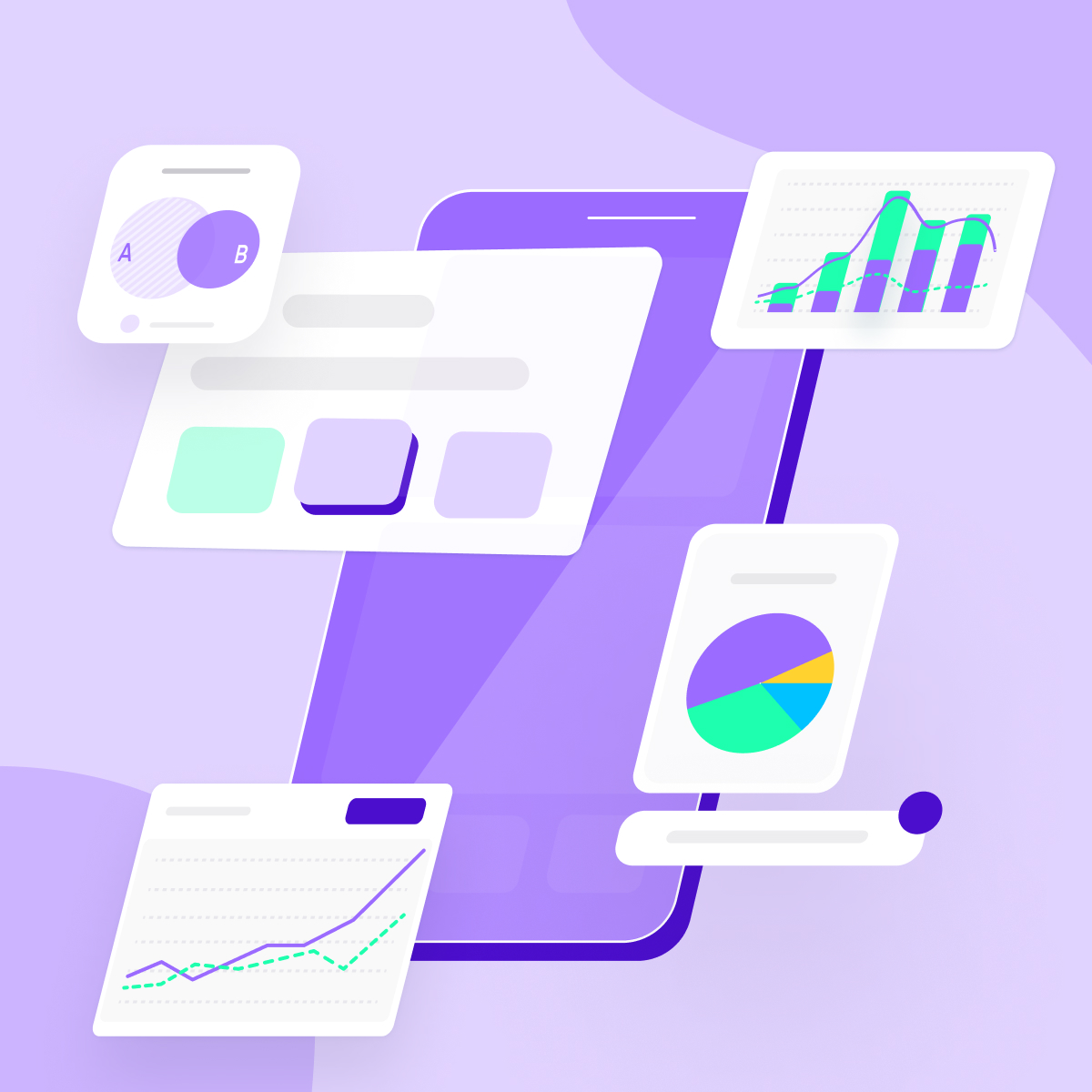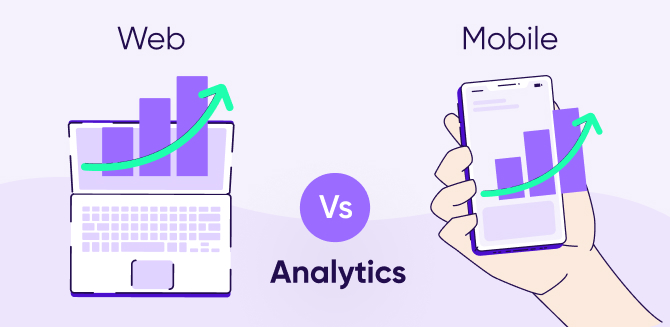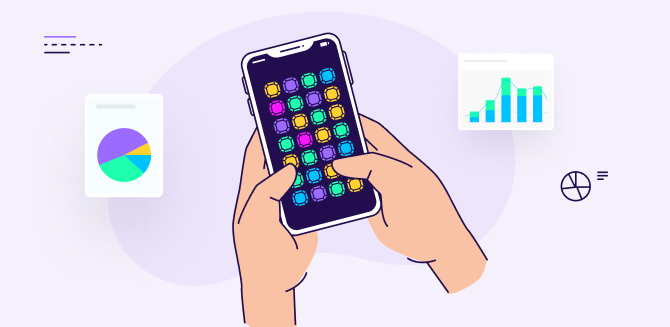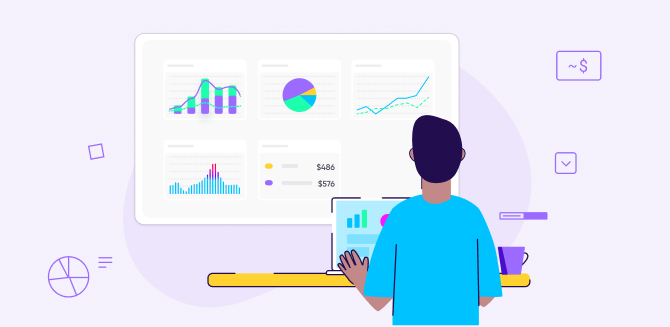Let’s be honest. Your main goal is to make your mobile app successful, right?
One of the best — and only — ways to do that is to regularly track your app’s performance.
But how do you do it? This is where app analytics comes in.
What is app analytics?
App analytics allows you to analyze your entire user journey.
You can see what content your users interact with, how long it usually takes them to complete a particular task, and when they decide to leave. All this information can make it easier to identify the elements of your application that hinder user retention and engagement, from complicated conversion funnels to unintuitive features.
App analytics generates real-time analysis and reports to help you quickly answer questions like:
- How many users have installed my app in total?
- What features of my app do people use most often? Which ones do they ignore?
- How do users interact and engage with my app?
- How many of my app’s users are active?
- Are my app’s users experiencing friction? Any UX problems? Technical issues?
Equipped with all that data, you can make relevant changes and updates to improve the user experience and build loyalty.
App analytics vs. web analytics
Web analytics refers to the collection, analysis, and reporting of data generated by users visiting and interacting with your website.
It uses a JavaScript tracking code in your website’s HTML source code to track data and identify your visitors using cookies.
Web analytics monitors the following metrics:
- Pageviews
- Sessions
- Unique pageviews
- Bounce rate
- Traffic sources
- Returning visitors
- New visitors
App analytics, on the other hand, gathers data from mobile applications. Rather than implementing a tracking code, it uses software development kits (SDKs) to track data and identify users by their device or operating system ID.
App analytics provides data for various engagement and usage metrics, like:
Why use app analytics?
App analytics is vital if you want to understand how well your app is meeting users’ needs, and what improvements you might need to make.
Let’s take a look at some of the benefits of integrating app analytics with your mobile app.
1. Collect accurate user data
With the help of app analytics, you can access real-time data that provides insights into what users need or want.
You can get information about your app’s most-liked functionalities or features — and the elements that don’t work so well. This accurate data collection can help you address the right issues, plan upgrades, and make relevant additions or changes.
2. Track business goals
With app analytics, you can easily determine the acquisition channels that generate the highest customer lifetime value (LTV). This can help you track business goals and develop essential marketing and engagement strategies in line with your budget.
3. Increase user engagement and retention
Mobile app analytics lets you analyze the complete user journey inside your application. The reports let you see what content users interact with and when they decide to leave. Having all this information makes it easier to identify where you can make improvements for better engagement and retention.
4. Deliver personalized, customer-focused marketing
With app analytics, you can create an individualized customer experience.
It provides valuable insights about user profiles and behavior that you can use to create effective marketing and re-engagement strategies.
A McKinsey study revealed that 71% of customers expect businesses to deliver personalized interactions, and 76% get frustrated when this doesn’t happen.
For example, let’s say a user has added a product to their cart but hasn’t completed the transaction. You can use app analytics to determine where in the journey they dropped off and adapt your marketing strategy accordingly. If they follow all the steps but drop off at the payment page, you can send them an in-app message offering a discount code to encourage them to complete their purchase.
What should I measure?
App analytics tracks several key performance indicators (KPIs), or quantifiable indicators of app performance. It’s important to select the most relevant KPIs based on the goals you want to achieve.
Here are some of the most commonly tracked metrics.
Revenue KPI metrics
These KPI metrics help you determine whether your application generates enough revenue to be sustainable, how much you spend on your marketing efforts, and if you’re experiencing a good return on investment (ROI).
For example, you can track:
User experience and performance KPI metrics
User experience (UX) and performance KPI metrics provide you with data relating to your application’s technical performance: how easy is it to use your app successfully?
They help you identify in-app performance issues, such as bugs, slow loading, or problems with the layout of your app.
Here are the UX and performance KPI metrics you can track using app analytics:
- Devices and operating systems
- Load speed
- Screen resolution
- Time spent in-app
- Task success rate
- User error rate
- Crash reports
Engagement KPI metrics
As the term implies, these metrics highlight your application’s user engagement. In general, the more engaged your users are, the more revenue you generate.
Here are the engagement KPI metrics that most mobile app developers or owners follow:
App analytics best practices
Now you know what app analytics can do for you, it’s time to make sure you’re using the tools correctly. Consider these tips to help you make the best of your mobile app analytics:
Use mobile app analytics from the get-go
The data you can gain from app analytics comes in handy from the moment you start testing your app. If you begin tracking data early enough, you can better understand your application, its most prominent weaknesses and strengths, and how much you’ve progressed or grown as a company.
Focus on the metrics that matter
You can track various app metrics, but you should identify the ones that best support your main goals.
For example, if you want to increase user engagement and retention, then you should track your app’s retention rate — the percentage of users who continue to use your app over a set period — instead of its download rate.
Benchmark your application against the competition
App metrics can help you identify and address issues like low retention rates. However, the figure by itself may not mean very much: you can gain more insights from your data by comparing it with the wider industry.
Statista research shows that retention levels vary by industry, with business and shopping apps typically sticking around longer than those relating to leisure and tourism, for example.
Let’s say the average app retention rate in your industry is about 30%, but your app has 10%. In this case, there’s probably an issue with your app that you need to address.
A benchmarking analysis can help you determine which aspects of your application you should focus on to keep up with (or outshine) the competition.
Types of app analytics tools
We can divide app analytics tools into different categories, depending on the metrics they track. Read on for a brief description of each one, so you can understand which tools will provide the data you need to help your app succeed.
In-app analytics
In-app analytics tools allow you to track everything a user does within your app and monitor user engagement. These tools also provide essential metrics, such as user demographics and device information.
App performance analytics
Performance analytics tools technically fall within the in-app category, but they focus less on your users and more on the app itself.
These tools perform audits that help identify any errors that may arise while your app is running. From uptime (measures the time your application is working) to responsiveness, resource usage, and crashes, you can understand when your application works, slows down, or fails on different devices – and fix issues that may be driving users away.
App advertising analytics
An app advertising analytics tool is essentially the heart of any successful marketing campaign.
It tracks your app’s performance on various marketing channels and helps you analyze ad clicks and in-app behaviors. With this information, you can adjust your marketing focus for an instant mobile or in-store sales boost.
App advertising tools also let you gauge returns on advertising spending. You can use the data to better connect with your target audience and allocate your marketing spend more effectively.
How do I choose the right app analytics tool for me?
With so many tools available, and new ones coming out every year, it can be hard to know which one to choose. These tips will help you navigate the market and decide which tool best meets your needs.
- Review the pricing: It might sound obvious, but you should always review a tool’s pricing policy before you commit. Determine the minimum cost and the available growth options, transactional average rates (if any), and fair use policies. These details can help you choose a cost-effective tool.
- Check its key features: Find out what core features the tool provides in addition to the basics, such as push notifications, A/B testing, and tracking fundamental KPIs.
- Choose the right level of detail for your app: Let’s say you’re launching your first app. In that case, a standard analytics tool may provide all the information you need for now. However, if your app is highly original and requires specific insights, consider an option that offers customizable metrics.
- Determine the level of support the tool offers: You want a mobile app analytics option that provides the right support where and when you need it. Find out how much documentation the tool offers and check if it has a 24/7 hotline or an account manager to help you when things go wrong.
Key takeaways
- Mobile app analytics refers to the accumulation and measurement of data from app activity. It provides information about your app’s performance on multiple levels (such as user behavior, app performance, and marketing) to inform your whole user journey.
- A web analytics tool tracks website data, while a mobile app analytics tool tracks app data.
- App analytics tools help you improve the user experience through better acquisition, improved performance and personalized marketing. This can lead to better retention and higher ROI.
- You can track different KPI metrics depending on your business goals: for example, revenue, engagement, UX, and performance.
- Before you invest in an app analytics tool, be sure to check out its pricing structure, features, metrics, and support.
FAQs
What is app analytics, and why is it important?
App analytics analyzes your entire user journey, helping you understand how users interact and engage with your app. This insight is crucial for improving user experience and boosting engagement and retention.
How does app analytics differ from web analytics?
While web analytics tracks website data using cookies and JavaScript, app analytics tracks mobile app data using SDKs, focusing on metrics like acquisition, retention, engagement, conversion rates, and uninstalls.
How can app analytics help improve user engagement?
By analyzing user interactions and identifying friction points within the app, app analytics allows you to make data-driven changes that enhance user experience and increase engagement.
What types of app analytics tools are available?
There are various tools to track different metrics. Use in-app analytics for measuring user behavior, app performance analytics for monitoring technical issues, and app advertising analytics for evaluating marketing effectiveness. Be sure to choose a tool that aligns with your app’s complexity and data needs.
Why should I benchmark my app’s performance against competitors?
Benchmarking helps you understand your app’s performance in the context of industry standards, allowing you to identify areas for improvement and stay competitive. Retention rates vary by industry, so it’s most insightful to compare against apps in your niche.









